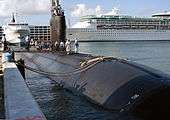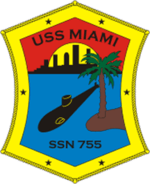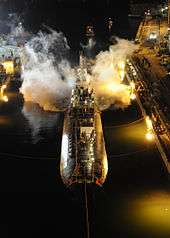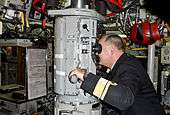USS Miami (SSN-755)
 USS Miami moored to a Port Everglades pier in April 2004. | |
| History | |
|---|---|
| Name: | Miami |
| Namesake: | City of Miami, Florida |
| Awarded: | 28 November 1983 |
| Builder: | General Dynamics Electric Boat |
| Laid down: | 24 October 1986 |
| Launched: | 12 November 1988 |
| Sponsored by: | Jane P. Wilkinson |
| Commissioned: | 30 June 1990 |
| Decommissioned: | 28 March 2014 |
| Out of service: | 8 August 2013 |
| Homeport: | Groton, Connecticut, U.S. |
| Identification: | SSN-755 |
| Motto: | "No Free Rides, Everybody Rows!" |
| Fate: | Removed from service, sent for scrapping[1][2] |
| Badge: |
 |
| General characteristics | |
| Class and type: | Los Angeles-class submarine |
| Displacement: | |
| Length: | 110.3 m (361 ft 11 in) |
| Beam: | 10 m (32 ft 10 in) |
| Draft: | 9.4 m (30 ft 10 in) |
| Propulsion: | S6G nuclear reactor |
| Complement: | 12 officers, 98 men |
| Armament: |
|
USS Miami (SSN-755) was a United States Navy Los Angeles-class attack submarine. She was the third vessel of the U.S. Navy to be named after Miami, Florida. Miami was the forty-fourth Los Angeles-class (688) submarine and the fifth Improved Los Angeles-class (688I) submarine to be built and commissioned. The contract to build her was awarded to the Electric Boat division of General Dynamics Corporation in Groton, Connecticut, on 28 November 1983 and her keel was laid down on 24 October 1986. She was launched on 12 November 1988 and commissioned on 30 June 1990 with Commander Thomas W. Mader in command.
On 1 March 2012 Miami pulled into the Portsmouth Naval Shipyard in Kittery, Maine for a scheduled 20-month Engineered Overhaul (EOH) and system upgrades. A civilian employee started a fire aboard the boat on 23 May 2012. It impacted the forward compartment of the submarine which includes crew living, command and control spaces and torpedo room. The revised estimate to restore Miami increased to approximately $450 million with completion estimated on 30 April 2015. Due to budget cuts, it was announced 6 August 2013 that the vessel would not be repaired and placed on the inactive list.[1] On 28 March 2014, Miami was formally decommissioned.[3]
History
1999
Miami became the first submarine to conduct combat operations in two theaters since World War II (Operation Desert Fox and Operation Allied Force).[4]
2012 fire

At 5:41 p.m. EDT on 23 May 2012, fire crews were called with a report of a fire on Miami while being overhauled at the Portsmouth Naval Shipyard in Kittery, Maine. At the time the submarine was on a scheduled 20-month maintenance cycle,[5][6] indicating the submarine was undergoing an extensive overhaul called an "Engineering Overhaul".[7] Injuries to seven firefighters had been reported by national media.[8] One crewmember suffered broken ribs when he fell through a hole left by removed deck plates during the fire.[9] It took firefighters 12 hours to extinguish the fire.[10]
Originally the U.S. Navy reported that the fire started when an industrial vacuum cleaner, used "to clean worksites on the sub after shipyard workers’ shifts," sucked up a heat source that ignited debris inside the vacuum. On 23 July 2012 Casey J. Fury, a civilian painter and sandblaster working on the sub, was indicted on two counts of arson after confessing to starting the fire. Fury admitted to setting the 23 May fire by igniting some rags on the top bunk of a bunk room. He claimed to have started the fire to get out of work early.[11][12][13][14] On 15 March 2013 Fury was sentenced to over 17 years in federal prison and ordered to pay $400 million in restitution.[15]
The U.S. Navy debated on whether to scrap the boat. Both of Maine's Senators, Susan Collins and Olympia Snowe, advocated repairing her.[16] The U.S. Navy asked Congress to add $220 million to the operations and maintenance budget for emergent and unfunded ship repairs which would be used to help repair Miami.[17] The final outcome was a choice to repair the submarine at an estimated total cost of $450 million. The boat was expected to return to service sometime in 2015.[18] However, congressional inaction to fully resolve the United States fiscal cliff had put this in doubt.[19]
To keep costs down, spare parts from the recently decommissioned Memphis were to be used to repair Miami.[20] Furthermore, integrity checks on the hull did not show changes to its metallurgy or strength; fixing the internal sections would be much cheaper than replacing hull sections.[21] At first glance, it seemed more prudent to repair Miami in the same manner as the fellow Los Angeles-class boat San Francisco since such a repair would cost "only" (around) 80 million USD.[22] However, it should be noted that the hull of Memphis was already 26 years old (as of 2012). Memphis is also a different version (or "flight") of 688 submarine, as it was not built with the vertical launch system that the newer Miami has,[23] thus making the hull of Memphis incompatible with that of Miami.
On 6 August 2013, the U.S. Navy announced its intention to decommission Miami, concluding the cost of repairs is more than it can afford in a time of budget cuts. A "comprehensive damage assessment" found that while the boat could have theoretically been repaired, the necessary repairs were more extensive than first anticipated. This raised the expected repair costs from $450 million to $700 million. At that cost, repairing the boat would have required the cancellation of work on several other submarines and surface ships. In the end, the Navy determined that repairing Miami was not considered worth weakening overall fleet readiness. One factor in the heightened cost estimate was the effect of "environmentally-assisted cracking" in the steel piping and fasteners used in the air, hydraulic, and cooling water systems, which required more equipment to be replaced than previously thought. The U.S. Navy will lose five deployments Miami was to make over the ten years that remained in its service life, but funds will be used to support other vital maintenance efforts to improve the wholeness and readiness of the fleet.[24] The sub was officially decommissioned on 28 March 2014, to be disposed of via the nuclear Ship-Submarine Recycling Program.[25]
Miami is the first submarine and nuclear-powered ship to be lost in a U.S. naval shipyard, and the second warship lost in a U.S. naval shipyard after the loss of the steam frigate Merrimack in 1861.
Commanding officers
USS Miami had eleven commanding officers (COs), all with the equivalent rank of commander, over her lifetime.
Commander Rolf B. Spelker served as Miami's eleventh and final commanding officer after assuming command from Commander Roger E. Meyer at Portsmouth Naval Shipyard. The Navy's announcement of her decommissioning means Meyer was the last commanding officer to have deployed with the ship itself. The start of the ship's original engineering overhaul (EOH) and later fire recovery overhaul were overseen by Meyer from March 2012 to November 2013. Spelker oversaw the defueling of the ship's nuclear reactor, inactivation, and decommissioning.
Commanding Officers
- Commander Thomas W. Mader (1988 – 1990)
- Commander Houston K. Jones (1990 – 1993)
- Commander Don H. Potter, Jr. (1993 – 1995)
- Commander Larry B. Olsen (1995 – 1998)
- Commander James P. Ransom, III (1998 – 2000)
- Commander Randall G. Richards (2000 – 2003)
- Commander Joseph B. Wiegand (2003 – 2005)
- Commander Richard R. Bryant (2005 – 2008)
- Commander Dennis R. Boyer (2008 – 2010)
- Commander Roger E. Meyer (2010 – 2013)
- Commander Rolf B. Spelker (2013 – 2014)
Previous mottos
- "Can do, will do, glad to." This motto was used prior to operation Desert Fox.
- "First to fire. Twice to fire." This motto was adopted after returning to home port after the 1998-1999 deployment.
In popular culture

- USS Miami is one of two vessels featured in Submarine: A Guided Tour Inside a Nuclear Warship, a 1993 non-fiction book by Tom Clancy.[26]
- In 1999, the ship was featured in The Learning Channel's Extreme Machines on "Nuclear Submarines".
Gallery
-
.jpg)
Tugboats maneuver Miami into a berth at Port Everglades, Florida on 17 July 1993.
-
_docked.jpg)
A bow on view looking down on Miami resting in the auxiliary medium repair dock Shippingport (ARDM-4) during a routine hull inspection at Naval Submarine Base Groton. (16 Mar. 1994)
-

Miami, homeported in Groton, Connecticut, sits moored to a pier as Sailors prepare to participate in Fleet Week. (26 Apr. 2004)
-
%2C_man_the_rails.jpg)
Sailors aboard Miami man the rails as they prepare to moor at Port Everglades Florida, Fleet Week. (26 Apr. 2004)
-
_surfaces_in_the_North_Arabian_Sea_during_an_anti-submarine_warfare_(ASW)_exercise_with_the_Enterprise_Carrier_Strike_Gro.jpg)
Miami surfaces in the North Arabian Sea during an anti-submarine warfare (ASW) exercise with the Enterprise Carrier Strike Group. The three-day, multi-unit exercise is aimed at enhancing the strike group's ASW capabilities. Miami is underway on a scheduled deployment as part of the Kearsarge Expeditionary Strike Group. (11 November 2007)
-
.jpg)
Santa Claus stands with sailors aboard Miami during the submarine's return to Naval Submarine Base New London after an eight-month deployment. (2 Dec. 2009)
-
_transits_the_Thames_River.jpg)
Sailors aboard Miami man the rails as the submarine transits the Thames River en route to Naval Submarine Base New London after a six-month deployment. (2 Dec. 2009)
-
..jpg)
Sailors aboard the nuclear submarine Nautilus salute the sailors aboard Miami as the boat returns home to Naval Submarine Base New London following a six-month deployment. (2 Dec. 2009)
-

Rear Adm. Bernt Grimstvedt, chief of the Royal Norwegian Navy, looks through the periscope. Grimstvedt toured Miami during a port visit to strengthen maritime partnership with Norwegian counterparts. (11 Oct. 2011)
-
_returns_home_to_Submarine_Base_New_London.jpg)
Miami returns home to Submarine Base New London following a five-month deployment conducting operations in the U.S. 6th Fleet area of responsibility. (15 Dec. 2011)
-
_returns_home_to_Submarine_Base_New_London.jpg)
Miami returns home to Submarine Base New London following a five-month deployment conducting operations in the U.S. 6th Fleet area of responsibility. (15 Dec. 2011)
References
- 1 2 Miller, Kevin; Hoey, Dennis (6 August 2013). "Navy abandons plan to fix nuclear sub burned in Maine". Kennebec Journal. Retrieved 5 July 2015.
- ↑ Archived 7 October 2013 at the Wayback Machine.
- ↑ "Decommissioning today for fire-damaged sub Miami". Militarytimes.com. Associated Press. 28 March 2014. Retrieved 5 July 2015.
- ↑ "USS Miami (SSN 755) History". uscarriers.net. Retrieved 5 July 2015.
- ↑ "Fire Extinguished On Nuclear Submarine In Maine". CBS Boston. 24 May 2012. Retrieved 5 July 2015.
- ↑ "Fire reported on nuclear-powered submarine at Maine shipyard". Necn.com. 23 May 2012. Retrieved 2013-02-16.
- ↑ Pike, John (29 October 2003). "SSN-688 Los Angeles-class Engineered Refueling Overhaul (ERO)". Globalsecurity.org. Retrieved 5 July 2015.
- ↑ ABC's Good Morning America 24 May 2012
- ↑ Sharp, David (10 September 2012). "Nuclear Submarine Fire Sparks Two Navy Probes". Portland Press Herald.
- ↑ Sharp, David (6 August 2013). "Navy drops plans to repair fire-damaged submarine USS Miami, citing budget restraints". Times Colonist. Associated Press. Archived from the original on 30 October 2013. Retrieved 2013-02-16.
- ↑ "Navy: No update on USS Miami investigation". boston.com. Associated Press. Retrieved 5 July 2015.
- ↑ McMahon, Charles (23 July 2012). "Suspect in $400M sub blaze appears in court". seacoastonline.com. Retrieved 5 July 2015.
- ↑ "Man charged in fire on USS Miami". www.wcvb.com. Retrieved 5 July 2015.
- ↑ Canfield, Clarke (2012). "Civilian worker charged with setting both fires aboard, near submarine in Maine shipyard". Associated Press. Archived from the original on 23 July 2012. Retrieved 5 July 2015.
- ↑ Boyette, Chris (16 March 2013). "Shipyard worker sentenced to 17 years for $400 million submarine fire". CNN. Retrieved 5 July 2015.
- ↑ Hoey, Dennis (7 June 2012). "Navy: Fire on nuclear sub started in vacuum cleaner". Portland Press Herald. Retrieved 5 July 2015.
- ↑ McDermott, Jennifer (20 July 2012). "Links to USS Miami fire explored". theday.com. Retrieved 5 July 2015.
- ↑ "USS Miami Expected Back In Service In 2015". Hartford Courant. Archived from the original on 24 August 2012. Retrieved 2012-08-22.
- ↑ Sharp, David (18 March 2013). "Navy: Repairs to submarine Miami now uncertain". NavyTimes. Retrieved 5 July 2015.
- ↑
- ↑ "Fire and Fixes aboard USS Miami". Defenseindustrydaily.com. 2 October 2012. Retrieved 5 July 2015.
- ↑ Ewing, Philip (21 October 2008). "Transplant complete, attack sub floats again". NavyTimes. Retrieved 5 July 2015. (subscription required)
- ↑ Archived 29 October 2013 at the Wayback Machine.
- ↑ Breckenridge, Richard (7 August 2013). "USS Miami: A Tangible Impact to Readiness from Sequestration". Navy Live. Retrieved 5 July 2015.
- ↑ McDermott, Jennifer (29 March 2014). "Fire-stricken submarine USS Miami is decommissioned". The Day. Stars and Stripes. Retrieved 5 July 2015.
- ↑ Clancy, Tom (1993). Submarine: A Guided Tour Inside a Nuclear Warship. ISBN 0-425-13873-9.
External links
| Wikimedia Commons has media related to USS Miami (SSN-755). |
This article includes information collected from the public domain sources Dictionary of American Naval Fighting Ships and Naval Vessel Register.
- USS Miami at the Naval Vessel Register
- USS Miami command histories – Naval History & Heritage Command: 19901991199219931994199519981999200020012002